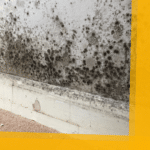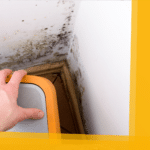Dealing with damp and mould
Addressing Mould: Essential Steps for Tenants and Landlords
Introduction to Mould in Housing
Mould is a serious concern across both the social and private rented sectors. It affects thousands of tenants every year and can cause damage to properties as well as harm to health. The main causes are rising damp, penetrating damp and condensation, usually linked to poor insulation, inadequate heating or limited ventilation. A damp problem can quickly escalate and lead to a mould problem if not addressed promptly.
Structural faults such as a leaking roof or missing roof tiles can also cause damp, which in turn can result in mould growth and further property damage.
Understanding how to prevent and deal with mould is essential for both tenants and landlords. The government’s recent focus on housing safety, particularly through Awaab’s Law, places clear legal duties on landlords to act quickly when damp or mould is found. If the source of the damp problem is not immediately clear, it is important for landlords to arrange for a qualified damp surveyor to inspect the property and identify the cause.
Damp conditions in a property can promote the growth of mould and other microorganisms, a situation often referred to as mould damp.



Understanding the Issue
Damp and mould are persistent challenges in the private rented sector and social housing, affecting the wellbeing of both private tenants and housing association tenants across the UK. Mould growth is often triggered by rising damp, penetrating damp, and poor ventilation, all of which can be exacerbated by structural faults such as rotten window frames or damaged external walls. It is essential for landlords to fix damp problems quickly to prevent mould forming and to protect the health of their tenants.
Housing associations and social landlords have a clear responsibility to maintain their housing stock and address damp and mould issues as part of their duty to provide safe, habitable homes. The National Housing Federation offers guidance and support to housing associations, helping them meet their obligations and improve housing conditions for social housing tenants. Under the Landlord and Tenant Act, both private and social landlords are legally required to keep rented properties in a reasonable state of repair, which includes addressing damp problems and ensuring that heating systems and extractor fans are working effectively.
Prolonged exposure to damp and mould can lead to a range of health problems, including skin rashes, respiratory issues, and other serious health risks. For this reason, tenants should report damp issues as soon as they notice them, and landlords must act urgently to remove moisture and prevent further mould growth. This may involve installing or repairing extractor fans, improving ventilation, and ensuring that heating systems are adequate. Tenants can also help by using proper ventilation and avoiding drying clothes indoors, which can contribute to excess moisture and mould issues.
The Housing Health and Safety Rating System (HHSRS) is used by local authorities to assess the safety of rented properties, including the risk of damp and mould. If landlords fail to address these issues, local authorities can take enforcement action, and tenants may be eligible for legal aid to seek compensation for health problems or damage to their belongings. Private tenants sometimes face additional challenges in getting landlords to fix damp and mould problems, but support is available from the Housing Ombudsman and local government.
Recent years have seen increased efforts to force landlords to take responsibility for damp and mould, most notably through the introduction of Awaab’s Law. This legislation, named after Awaab Ishak, a child whose tragic death was linked to prolonged exposure to mould in social housing -requires social landlords to act urgently when damp and mould are reported. The case of Awaab’s family has brought national attention to the need for higher standards in the housing sector and the importance of holding landlords accountable to prevent such tragedies in the future.
Health Risks and Housing Health
Identifying Health Risks
Long-term exposure to mould spores can lead to respiratory problems, allergic reactions and skin irritation. Children, older people and those with existing health conditions are especially at risk.
Good housing health is not just about comfort; it is about creating a safe living environment. The Housing Secretary, Steve Reed, has stressed that damp and mould are no longer minor maintenance issues but serious health hazards that must be dealt with quickly.
Legal Standards and Responsibilities
Housing Standards and Awaab’s Law
Awaab’s Law, which took effect in October 2025, introduced strict deadlines for social landlords to investigate and fix damp and mould problems.
The main requirements are:
- Action within 24 hours for emergency hazards.
- Inspection within 10 working days for significant damp and mould.
- Written findings provided within 3 working days after inspection.
- Homes made safe within 5 working days if hazards are found.
- Further repairs started within another 5 working days.
The Landlord and Tenant Act 1985 also requires both private and social landlords to keep homes in good repair and free from health hazards. In addition, the Decent Homes Standard sets out that all rented properties must be safe, warm and free from damp or mould.
Roles and Responsibilities
Tenant and Landlord Duties
Tenants should report damp and mould issues as soon as they appear, use heating and ventilation correctly, avoid blocking air vents and make sure extractor fans are working.
Landlords must investigate reports promptly, repair leaks or structural problems and maintain ventilation systems. They should also keep detailed records of reports, inspections and completed work.
If social housing tenants do not receive a response, they can contact the Housing Ombudsman. Private tenants can seek help from their local council, which can take enforcement action under the Housing Health and Safety Rating System (HHSRS).
Preventing Mould Growth
Practical Prevention Strategies
Both tenants and landlords can help to prevent mould:
- Keep rooms well ventilated by opening windows, especially after cooking or showering.
- Dry clothes outdoors where possible, or use a vented tumble dryer.
- Wipe condensation from windows and walls.
- Landlords should schedule regular inspections to catch early signs of damp.
- Fix leaks, maintain roofs and gutters and improve insulation where necessary.
Simple maintenance and ventilation steps can stop mould before it becomes a costly or dangerous problem.
Environmental Health Considerations
Local Authority Action
If damp or mould becomes severe, Environmental Health Officers can inspect a property and require landlords to make improvements. Under the HHSRS, mould is treated as a health hazard. Councils can issue improvement notices or carry out emergency repairs and then recover the costs from landlords.
These powers help ensure that tenants live in safe and habitable homes.
Decent Homes and Housing Conditions
Understanding the Decent Homes Standard
To meet the Decent Homes Standard, properties must be in reasonable repair, have modern facilities and be free from serious hazards such as mould and damp.
Poor ventilation, leaks or structural issues can breach this standard. Tenants have a right to live in safe accommodation, and landlords have a legal duty to maintain it to that level.
Addressing Health Issues
Dealing with Severe Cases
When mould has caused serious health problems, landlords may need to provide temporary accommodation while repairs take place. Damaged plaster, rotten window frames and contaminated materials should be removed and replaced. Repairs must address the underlying cause, not simply cover the damage.
If landlords fail to act, tenants can apply for legal aid and pursue disrepair claims in court.



Working Together for Healthier Homes
Tackling mould in rented homes requires cooperation between tenants, landlords and local authorities. Tenants should report problems early and take simple steps to reduce moisture, while landlords must respond quickly and maintain their buildings properly.
Awaab’s Law has made these duties clearer and more enforceable. By understanding the causes of mould, meeting legal requirements and keeping communication open, landlords and tenants can maintain safe, healthy and compliant homes.
When the problem keeps coming back
Sometimes, even after repeated repairs, mould and damp continue to return. Persistent problems like this can make a property costly to maintain and stressful to manage.
If you are a landlord facing ongoing mould issues or struggling with older housing stock, Speed Property Buyers offers a straightforward solution. We buy any property in any condition and provide a fast, reliable sale with no hidden fees.
Give us a call today and our friendly team will help you choose the best personalised solution for your circumstances.








